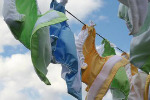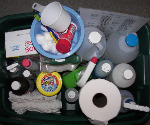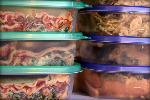
September 15, 2010
Welcome to the Out Darn Spot! Newsletter, from Stain-Removal-101.com.
If you like this newsletter please forward it to share it with your friends.
If you received this issue from a friend, please subscribe here so you can get your copy starting next month.
There are other ways to stay in touch with what's happening at Stain-Removal-101.com too.
For example, you can subscribe to the Stain Removal Blog to get updates as they happen.
You can also follow me on Twitter, or become a fan of Stain-Removal-101.com on Facebook.
Thanks for joining me today, and enjoy this issue!
Sincerely,
Taylor
Stain-Removal-101.com
Household-Management-101.com
If this newsletter is difficult to read as an email:
Read this newsletter issue online here.
In This Issue Of Out Darn Spot:
1. What's New At Stain-Removal-101.com
2. Natural Stain Remover Spotlight: Sunshine
3. How To Make Your Own Laundry Stain Removal Kit
4. Cleaning Tip Of The Month: Debunking A Big Natural Stain Removal Myth
5. Featured Stain Removal Tip - Removing Tomato Stains From Plastic
What's New At Stain-Removal-101.com
 Things have been very busy here at Stain-Removal-101.com during the last month, as I have continued to add more information to the site.
Things have been very busy here at Stain-Removal-101.com during the last month, as I have continued to add more information to the site.
This past month I have really been focusing on recipes for homemade cleaning products and homemade cleaners, because I think it is so important to know how to make effective cleaners using natural and simple ingredients.
Instead of listing all the recipes I have posted, or all the natural and simple ingredients I have been focusing on, I will list only the ten most popular posts I wrote in the past month about this subject. They are:
- Uses For Borax Powder For Cleaning, Laundry, Stain Removal And More
- Essential Oil Use Chart For Cleaning Your Home
- Cream Of Tartar Uses For Cleaning, Stain Removal And More
- Homemade Upholstery Cleaner Recipes
- Homemade Fabric Softener Recipes
- Bleach And Ammonia Don't Mix
- Homemade Laundry Detergent Recipes
- Homemade Dishwasher Detergent Recipes
- Homemade Cleaning Supplies - Ingredients And Equipment Needed
- Homemade Laundry Starch Recipe
In addition, let's continue on with the tour of the website that I started in the previous issue of this newsletter. As you may recall last time I showed you the main areas of the site dealing with stain removal.
This month I would like to introduce you to the areas of the site devoted to cleaning your home. As with any website this one is a work in progress, and I don't have everything up yet. However, I plan to keep adding resources and how-to guides to this site to make it a complete resource for advice and tips for cleaning your home.
Right now I have already created an area of the site where you can share your own cleaning tips.
I have been adding some of my own tips here, as well as posting some great how-to videos from around the web. I would love to hear your tips too though, since that is what this area of the site is about. I have divided this cleaning tips area into some big categories, to make it easier for people to find the type of cleaning tips they want to read about, or share, such as for upholstery, suede, or mattresses. I am also planning to add quite a number of additional categories in the future.
As I mentioned last time, if you have your own website or blog and would like me to feature a post you have already done on your site where you provided a cleaning tip I would love to do it. I would need to be able to quote portions of your article, and show your pictures, and in exchange I would provide you with a link to your total article.
In addition, the other areas of the site dealing with cleaning your home, so far, are those about making your own cleaning products, which I have already discussed above. Please note you can also contribute your own homemade cleaners recipes, so I would love to hear what works for you!
I think I have now concluded my tour of the website, but I will continue to keep you updated as I add new features and sections over time.
Natural Stain Remover Spotlight: Sunshine
 Each month, here in the newsletter, I focus on a different stain remover and show its great attributes and any downsides it may have.
Each month, here in the newsletter, I focus on a different stain remover and show its great attributes and any downsides it may have.
This month's focus is on sunshine, which is a great stain remover for many reasons not least of which is that it is completely free! In addition, it does not harm the environment at all when we use it.
Sunlight, because of its ultraviolet (UV) rays, can be used as a great way to remove many stains. For example, putting a baby's cloth diapers out to dry on the line is a great way to also remove many lingering stains from them.
Another bonus of sunning items, besides stain removal, is that at the same time the sun kills germs and can help eliminate odors. These same UV lights kill dust mites and some bacteria, including those bacteria which cause odors. Therefore, the old methods of dragging out mattresses, carpets, upholstered furniture, pillows, and other items to sun are still effective for freshening and cleaning your household items. Seems like our ancestors really did know what they were doing when they would sun things to help clean them.
Of course, just as too much sun on our skins can be a bad thing, so it is with too much sun on our household items. The same UV rays that remove stains and kill germs can also fade, age and bleach things like wood, fabric and photographs. Therefore, you need to find a happy medium in your home for using sunlight effectively.
You can learn even more about sunshine for stain removal and cleaning here.
Sneak Peek: October's spotlight will be on hydrogen peroxide.
How To Make Your Own Laundry Stain Removal Kit
 Laundry stains can happen very quickly and you need to be prepared to treat them just as quickly. To be prepared you can gather up the ingredients for a laundry stain removal kit ahead of time, and keep it in your laundry room to grab items as needed to fight stains.
Laundry stains can happen very quickly and you need to be prepared to treat them just as quickly. To be prepared you can gather up the ingredients for a laundry stain removal kit ahead of time, and keep it in your laundry room to grab items as needed to fight stains.
This month we will focus on several common stain removers you can use in your stain removal kit. I have tried to add as many natural and green items to this list as possible, when they are as effective as commercial products, since they are generally cheaper and are better for the environment and your health. In addition, recall you can also use many of your normal laundry supplies, such as laundry detergent and bleaches to help you remove stains too.
1. Baking soda: Baking soda can be a gentle laundry booster when added to the wash. In addition, it (or cornstarch) can be used as an absorbent for greasy stains. Just sprinkle the baking soda onto the greasy stain and let it sit for 15-20 minutes to absorb the oils and then scrape it away.
2. Borax: Borax is also a natural laundry booster, and can also be used as part of certain homemade stain remover recipes. One way borax works is by softening the water, thereby allowing the detergents to work better on your clothes. Borax is also great for soaking cloth diapers. You can see more uses for borax powder here.
3. Dishwashing liquid: A bleach free, lanolin free mild dishwashing liquid, such as Dawn, can work wonders on oily and greasy stains. Since it can cut grease from your dishes it can do the same on your clothes. Just rub a little dishwashing liquid into the oily stain with a toothbrush and then rinse away both the soap and oil from your fabric. I have personally never had a problem using a colored dishwashing liquid when removing stains, but some people caution to use only clear dishwashing liquid for stain removal so you don't accidentally get a stain from the soap itself.
4. Meat tenderizer (unseasoned): If your laundry detergents or stain removers do not contain enzymes you will need to add some when treating protein based stains like blood, milk, and grass. You can make a paste of unseasoned meat tenderizer and water, and apply this to the stain for approximately 30 minutes to help break down the proteins within the stain, and then brush off the paste and launder. Another source for enzymatic treatments for your stains is to use the contents of digestive enzyme tablets that you can purchase at health food stores.
5. Ammonia: Make sure you use the non-sudsing, non-scented variety of ammonia for stain removal. Ammonia, as a mildly strong alkaline solution, can be helpful for removing some really stubborn stains like dried blood, sweat, pen ink, and urine stains. Always test in an inconspicuous area before applying to the stain (generally in a diluted form), and never mix with chlorine bleach as toxic fumes can result.
6. White vinegar: White vinegar is a mild acid, and is helpful for neutralizing odors and also for removing many types of food stains. Vinegar has gotten to be a very popular laundry additive in recent years too, because it can help make sure all detergent is thoroughly rinsed from the fabric, and it helps soften clothing without having to use commercial fabric softeners. Please note, however, that repeated exposure to vinegar will slowly weaken certain natural fabrics, such as cotton, because of its acidic nature.
7. Rubbing alcohol: This stain remover works well to remove ink, and also for stubborn berry stains, among others. In a pinch you can also use waterless hand sanitizer for oil and grease stains, and then rinse with warm water.
8. Hydrogen peroxide: Be sure to use a 3% solution of hydrogen peroxide, the kind that is sold in the brown bottle for first aid, not the stronger version sometimes used for hair bleaching. Hydrogen peroxide is a natural bleaching agent that works similarly to oxygen bleach. It can be helpful in removing blood and chocolate stains, especially. It can also be used as an alternative to chlorine bleach in the wash as a natural whitener. Always test it in an inconspicuous area before applying to the stain to check for color fastness.
9. Nail polish remover: Nail polish remover is definitely not a natural product, and generally contains acetone. It can be used to remove such stains as nail polish or correction fluid, like White-Out, from clothing. Do not use it on fabrics containing acetate, rayon, silk or wool because it can harm these fibers (it will literally melt acetate). It should also be used in a well ventilated area only. Always test in an inconspicuous area before applying to the stain.
I hope this helps you make your own laundry stain removal kit. Next month I will discuss some stain removal equipment you should have for your stain removal kit, to go with all these stain removers.
Cleaning Tip Of The Month: Debunking A Big Natural Stain Removal Myth
 As you may be able to tell from many of the articles on my site I like to focus on natural and green cleaning methods here at Stain-Removal-101.com. I am very glad that this topic is beginning to become more mainstream, and is becoming more and more popular. Unfortunately, as even more information is published in this area I am seeing lots of misinformation out there too.
As you may be able to tell from many of the articles on my site I like to focus on natural and green cleaning methods here at Stain-Removal-101.com. I am very glad that this topic is beginning to become more mainstream, and is becoming more and more popular. Unfortunately, as even more information is published in this area I am seeing lots of misinformation out there too.
Some of my biggest pet peeves include when someone says that vinegar disinfects (it does not, at least no more than lemon juice), and when someone suggests adding an acidic ingredient, such as vinegar, with a basic ingredient, such as ammonia, when making homemade cleaners, since it disregards the way these cleaners clean, based on the pH scale. In fact, one of my missions here at Stain-Removal-101.com is to provide scientifically correct information so we can effectively clean our homes. I will be debunking several cleaning myths over the next few months here in this newsletter, and also on the website.
A sneak peak for October in the newsletter is to explain the pH scale more thoroughly, so everyone understands how it impacts cleaning our homes.
So, what are my qualifications for these scientific explanations that are on the site? Well, I am no scientist, but I did major in biology in college and in the course of getting my bachelor of science I took my fair share of chemistry courses. That gave me the basics, and that is more than enough to share with you. Cleaning properly involves a very small knowledge of scientific principles, but not really complicated stuff.
So this month the myth I am debunking is the old saw that you should use club soda for stain removal and cleaning. Some of the most standard advice in many green cleaning books and websites is to use club soda as a stain remover. Well, I kept reading this many times but every time I did I kept wondering, what is it, chemically, about club soda that would make it such a powerful stain remover? Well, I was surprised to find out that Scientific American had also tackled this topic, and concluded that club soda doesn't work much better, if at all, than plain water, in helping to remove stains. Here is a link to my article on debunking the myth of club soda as a stain remover to read my entire analysis and thoughts about this topic, including a link to the magazine article.
Featured Stain Removal Tip - Removing Tomato Stains From Plastic
 I love to cook extra food at dinner time, and then save the leftovers for another meal, such as for lunch the next day. One of the best things to make extra of is pasta, since it warms up so well. Unfortunately, when you save pasta with a tomato sauce in plastic containers it can cause stains in your plastic containers.
I love to cook extra food at dinner time, and then save the leftovers for another meal, such as for lunch the next day. One of the best things to make extra of is pasta, since it warms up so well. Unfortunately, when you save pasta with a tomato sauce in plastic containers it can cause stains in your plastic containers.
This was bothering me recently, and so I decided to investigate what works best for removing these stains, and then share my tips with you. You can read my entire article on how to remove tomato stains from plastic here.
I added this as my featured stain removal tip for the month because one of the best ways to remove these tomato stains is to set the plastic out in the sunlight to bleach the stains away. I thought it was perfect, since the featured natural stain remover for the month is sunlight!
Thanks For Joining Me For The Out Darn Spot! Newsletter
~Stain-Removal-101.com: Your First Stop When Stains Happen~
If you have any questions about this newsletter, or you thought of something you wanted to tell me, you can contact me here.
I hope you have enjoyed this second issue of the Out Darn Spot! Newsletter!
I'll talk to you again next month. And again, if you enjoyed this newsletter please send it to a friend and encourage them to subscribe too!
Sincerely,
Taylor
Subscriber count: Over 100! (It has doubled since last month -- how exciting!)